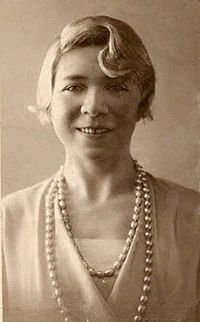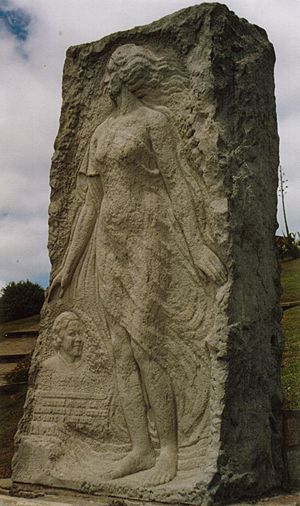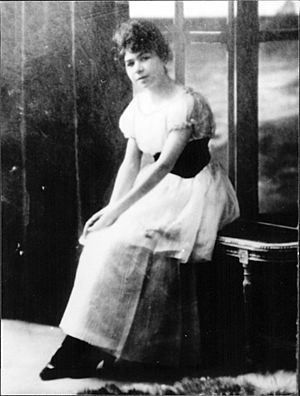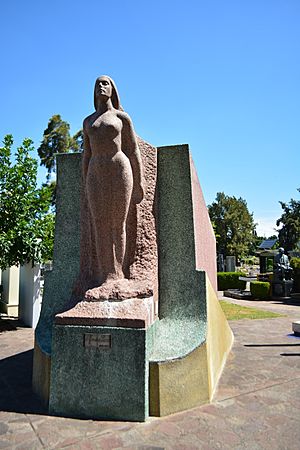Alfonsina Storni facts for kids
Quick facts for kids
Alfonsina Storni
|
|
|---|---|
 |
|
| Born | 22 May 1892 Sala Capriasca, Switzerland |
| Died | 25 October 1938 (aged 46) Mar del Plata, Argentina |
| Resting place | La Chacarita Cemetery |
| Language | Spanish |
| Nationality | Argentine |
| Literary movement | Modernism |
| Notable works | Ocre ("Ochre") El dulce daño ("Sweet pain") |
| Signature | |
 |
|
Alfonsina Storni (born May 29, 1892 – died October 25, 1938) was a famous Argentine poet and writer. She was part of the modernism movement in literature.
Alfonsina was born in Switzerland. She became one of the first women in Argentina to become successful in writing and theater. Her work often talked about women's rights and challenged old ideas about how men and women should act. She became well-known after publishing many poetry books. She also wrote plays for children. She was friends with other important writers like Horacio Quiroga and Gabriela Mistral.
Contents
Discovering Alfonsina Storni's Early Life
Alfonsina Storni was born on May 29, 1892, in Sala Capriasca, Switzerland. Her parents, Alfonso Storni and Paola Martignoni, were from Switzerland and Italy. Before Alfonsina was born, her father had a brewery in San Juan, Argentina. He made beer and soda there.
In 1891, her parents went back to Switzerland, where Alfonsina was born. She lived there until she was four years old. In 1896, her family returned to San Juan. A few years later, in 1901, they moved to Rosario because of money problems. Her father opened a tavern, and Alfonsina helped with many chores. But this business did not do well.
Alfonsina wrote her first poem when she was just twelve years old. She kept writing whenever she had free time. She later went to the Colegio de la Santa Union as a part-time student. In 1906, her father passed away. Alfonsina started working in a hat factory to help her family.
How Alfonsina Storni Began Her Career
In 1907, Alfonsina loved to dance. She joined a traveling theater group. This group took her all around the country. She acted in plays like Ghosts by Henrik Ibsen.
In 1908, Storni went back to live with her mother. Her mother had remarried and was living in Bustinza. After a year, Alfonsina moved to Coronda. There, she studied to become a primary school teacher for rural areas. During this time, she also started writing for local magazines. These included Mundo Rosarino and Monos y Monadas. She also wrote for the well-known magazine Mundo Argentino.
In 1912, she moved to Buenos Aires. She wanted to live in a big city where she could be more independent. At age nineteen, she became a single mother. She supported herself by teaching and writing for newspapers. Buenos Aires was a place where many women were starting to fight for their rights. This inspired Alfonsina.
Alfonsina Storni's Writing Journey
Alfonsina Storni was one of the first women to succeed in writing and theater in Argentina. These fields were mostly led by men at the time. She developed a special and important voice in Latin American poetry. Storni influenced many readers and other writers.
She was known mostly for her poems. But she also wrote stories, newspaper articles, and plays. Storni wrote about many topics. She talked about politics and how women were treated unfairly. Her writing style was unique. She is often called a postmodern writer.
Alfonsina Storni's First Published Works
In 1916, Storni published some of her first works. These appeared in the literary magazine La Nota. She wrote for this magazine regularly from March 1916 to November 1919. Her poems “Convalecer” and “Golondrinas” were published there.
Even though she faced money problems, she published her first book of poems, La inquietud del rosal, in 1916. Later, she started writing for the magazine Caras y Caretas. At the same time, she worked as a cashier in a shop. Today, Storni's early poems are very famous. But when they first came out, some male writers like Jorge Luis Borges criticized them.
Gaining Wider Recognition as a Writer
As the writing scene in Buenos Aires grew, Storni met other writers. These included José Enrique Rodó and Amado Nervo. Her financial situation got better. This allowed her to travel to Montevideo, Uruguay. There, she met the poet Juana de Ibarbourou. She also met Horacio Quiroga, who became a very good friend.
Between 1918 and 1920, Storni had a very productive time. She published three poetry books:
- El dulce daño (Sweet Pain) in 1918
- Irremediablemente (Irremediably) in 1919
- Languidez (Languor) in 1920
Languidez won the first Municipal Poetry Prize and the second National Literature Prize. This made her even more famous as a talented writer. She also wrote many articles for important newspapers and journals. Later, in 1925, she continued to experiment with her writing style in Ocre. This book was mostly made of sonnets, which are traditional poems.
Alfonsina Storni's Plays for Children
After her success with Ocre, Storni decided to write plays. Her first play for adults, El amo del mundo, was performed in 1927. However, it was not very popular. Many experts say that Argentine theater was not doing well at that time.
Alfonsina Storni also wrote several plays especially for children. These included:
- Blanco...Negro...Blanco
- Pedro y Pedrito
- Jorge y su Conciencia
- Un sueño en el camino
- Los degolladores de estatuas
- El Dios de los pájaros
These were short plays with songs and dances. She wrote them for her students at the Teatro Labardén theater. For Pedrito y Pedro and Blanco...Negro...Blanco, Alfonsina even wrote the music herself. These plays were performed in 1948 at the Teatro Colón theater in Buenos Aires. A writer named Julieta Gómez Paz said these plays "ironically present adult situations transferred to the children's world to outline errors, prejudice and damaging customs by adults, but corrected by the poetic fantasy with happy endings."
Later Works and New Styles
After almost eight years without publishing new poetry books, Storni released El mundo de siete pozos (The World of Seven Wells) in 1934. Her last book, Mascarilla y trébol (Mask and Clover), came out in 1938, just before she passed away. These two books show her most experimental poetry. In her final book, she used what she called "antisonnets." These poems used parts of traditional sonnets but did not follow the usual rhyming rules.
Alfonsina Storni's Friendships
Alfonsina Storni had important friendships with other writers.
Friendship with Gabriela Mistral
Around this time, Gabriela Mistral, a famous Chilean writer, visited Alfonsina at her home. Gabriela was very impressed by Alfonsina's voice when they spoke on the phone. She had heard that Alfonsina was not pretty. But when they met, Gabriela was surprised. She said Alfonsina's face did not match what she had been told.
Gabriela remembered Alfonsina's "extraordinary" head. She said it was "not because of her features, but because of her very silvery hair which framed her young face well." She added, "I haven’t seen more beautiful hair, it was as strange as the moonlight at noon." Gabriela was impressed by Alfonsina's simple and honest nature. She also admired Alfonsina's ability to understand everything around her. Gabriela Mistral called her a woman of a great city "who has passed, touching all and incorporating all."
Relationship with Horacio Quiroga
José María Delgado suggested to Horacio Quiroga that he should meet Storni in Buenos Aires. They started going to the movies together with their children. They also went to parties where many writers met. At one party, they played a game where Storni and Quiroga were supposed to kiss opposite sides of Quiroga’s pocket watch. But Quiroga moved the watch, and they kissed each other instead!
Quiroga often mentioned Storni in his letters between 1919 and 1922. The exact nature of their relationship is not fully known. But it was special because there were not many female writers at that time. Quiroga respected her work and treated her as an equal. They traveled to Montevideo together often. Quiroga was assigned to the Uruguayan consulate and was always with a female intellectual.
In 1925, Quiroga traveled to Misiones. Storni did not go with him. Instead, she traveled to San Ignacio. She let Quiroga stay in her apartment. She wrote to him, but he did not write back. After a year, Quiroga returned, and they became friends again. They met, read each other's writings, and went to movies and concerts.
Their close friendship ended in 1927. This was when Quiroga met Maria Elena Bravo and got married again. It is not known if they were ever in love. But Storni saw Quiroga as a friend who understood her. She wrote a poem for him when he passed away in 1937. This was just a year before her own death.
Alfonsina Storni's Health and Passing
In 1935, Alfonsina Storni found out she had breast cancer. On May 20, 1935, she had a major surgery. In 1938, she learned that the cancer had returned.
Around 1:00 AM on Tuesday, October 25, 1938, Storni left her hotel room. She walked towards the sea at La Perla beach in Mar del Plata, Argentina. Later that morning, two workers found her body on the beach.
She is buried in La Chacarita Cemetery in Buenos Aires. Her death inspired a famous song called "Alfonsina y el Mar" ("Alfonsina and the Sea"). This song was written by Ariel Ramírez and Félix Luna.
Alfonsina Storni's Works

- 1916 La inquietud del rosal ("The Restlessness of the Rosebush")
- 1916 Por los niños que han muerto ("For the kids that have died")
- 1916 Canto a los niños ("Sing to the Children")
- 1918 El dulce daño ("The Sweet Harm")
- 1918 Atlántida (collaboration)
- 1919 Irremediablemente ("Irremediably")
- 1919 Una golondrina
- 1920 Languidez ("Languidness")
- 1925 Ocre ("Ochre")
- 1926 Poemas de amor ("Love poems")
- 1927 El amo del mundo: comedia en tres actos (play)
- 1932 Dos farsas pirotécnicas (play)
- 1934 Mundo de siete pozos ("World of seven wells")
- 1938 Mascarilla y trébol ("Mask and trefoil")
- 1938 Voy a dormir ("I'm going to sleep")
Published after her death:
- 1938 Antología poética ("Poetic anthology")
- 1950 Teatro infantil ("Plays for children")
- 1968 Poesías completas ("Complete poetical works")
- 1998 Nosotras y la piel: selección de ensayos ("We (women) and the skin: selected essays")
Awards and Recognition for Alfonsina Storni
Alfonsina Storni received several awards for her work:
- In 1910, she earned her title as a "Maestra Rural" (Rural Teacher).
- In 1917, Storni received the Premio Annual del Consejo Nacional de Mujeres.
- In 1920, her book Languidez won the First Municipal Prize. It also won the second National Literature Prize.
- On May 29, 2018, Google celebrated Alfonsina Storni’s 126th Birthday with a special Google Doodle.
See Also
 In Spanish: Alfonsina Storni para niños
In Spanish: Alfonsina Storni para niños



